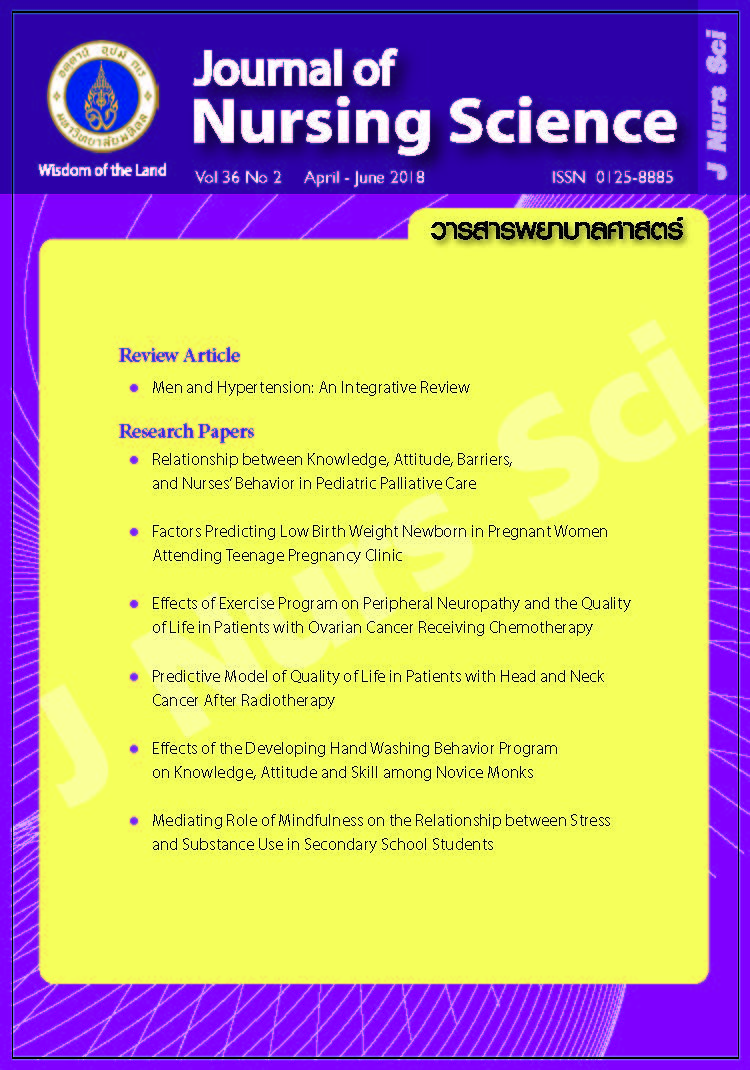ผู้ชายกับความดันโลหิตสูง การทบทวนบูรณาการ
Main Article Content
บทคัดย่อ
วัตถุประสงค์: เพื่อศึกษาความดันโลหิตสูงในผู้ชายจากหลักฐานเชิงประจักษ์
รูปแบบการศึกษา: เป็นการทบทวนวรรณกรรมแบบผสมผสาน โดยการศึกษางานวิจัยเชิงคุณภาพและเชิงปริมาณ ที่เกี่ยวกับความดันโลหิตสูงในผู้ชาย มีการสืบค้นหลักฐานเชิงประจักษ์ที่ตีพิมพ์ตั้งแต่ปี ค.ศ. 2007 ถึง 2017 จากฐาน ข้อมูล PubMed, CINAHL, Ovid MEDLINE, EBSCO และข้อมูลอ้างอิงที่เกี่ยวข้อง จำนวน 7 เรื่อง จากนั้นนำมาวิเคราะห์ และอธิบายโดยใช้การวิเคราะห์เนื้อหาแบบดั้งเดิม (conventional content analysis)
ผลการศึกษา: จากการวิเคราะห์เนื้อหา พบ 5 ประเด็นหลัก คือ 1) ความเข้าใจเกี่ยวกับอาการของโรคความดันโลหิตสูง 2) ความรู้เกี่ยวกับภาวะแทรกซ้อนของโรคความดันโลหิตสูง 3) ความร่วมมือเกี่ยวกับวิถีสุขภาพที่ดีและการรักษาด้วยยา 4) การจัดการตนเอง 5) โปรแกรมที่ออกแบบเพื่อส่งเสริมการควบคุมความดันโลหิต
สรุปและข้อเสนอแนะ: การมีประสบการณ์เกี่ยวกับอาการ และการมองว่าตนเองมีภาวะเสี่ยงเป็นสิ่งสำคัญสำหรับผู้ชายที่มีความดันโลหิตสูง ในการแสวงหาการดูแลสุขภาพ การวิจัยในอนาคตควรศึกษาและอธิบายให้ชัดเจนเกี่ยวกับการพัฒนาการรับรู้ความเสี่ยงของตนเองของผู้ชายโรคความดันโลหิตสูง ปัจจัยที่สามารถมีส่วนให้เกิดการพัฒนาการรับรู้ความเสี่ยง และการรับรู้ความเสี่ยงกระตุ้นให้ผู้ชายโรคความดันโลหิตสูงมีการเปลี่ยนแปลงพฤติกรรมอย่างไร
Article Details
ลิขสิทธิ์: วารสารพยาบาลศาสตร์เป็นเจ้าของลิขสิทธิ์ในการเผยแพร่ผลงานที่ตีพิมพ์ ห้ามผู้ใดนำบทความที่ได้รับการตีพิมพ์ในวารสารพยาบาลศาสตร์ไปเผยแพร่ในลักษณะต่างๆ ดังต่อไปนี้ การส่งบทความไปตีพิมพ์เผยแพร่ที่อื่น การนำบทความเผยแพร่ออนไลน์ การถ่ายเอกสารบทความเพื่อกิจกรรมที่ไม่ใช่การเรียนการสอน ยกเว้นเสียแต่ได้รับอนุญาตจากวารสารพยาบาลศาสตร์

Disclaimer: เนื้อหาบทความหรือข้อคิดเห็นใดๆ ในวารสารพยาบาลศาสตร์ ถือเป็นความรับผิดชอบของผู้เขียน กองบรรณาธิการไม่จำเป็นต้องเห็นด้วยและไม่มีส่วนรับผิดชอบแต่อย่างใด
References
2. Saeed AA, Al-Hamdan NA, Bahnassy AA, Abdalla AM, Abbas MA, Abuzaid LZ. Prevalence, awareness, treatment, and control of hypertension among Saudi adult population: a national survey. Int J Hypertens. 2011;2011:174135. doi: 10.4061/2011/174135. PubMed PMID: 21912737; PubMed Central PMCID: PMC3168271.
3. Ibrahim MM, Damasceno A. Hypertension in developing countries. Lancet. 2012;380(9841):611-9.
4. Gao Y, Chen G, Tian H, Lin L, Lu J, Weng J, et al. Prevalence of hypertension in China: a cross-sectional study. PLoS One. 2013 Jun 11;8(6):e65938. doi: 10.1371/journal.pone.0065938. PubMed PMID: 23776574; PubMed Central PMCID: PMC3679057.
5. Helelo TP, Gelaw YA, Adane AA. Prevalence and associated factors of hypertension among adults in Durame Town, Southern Ethiopia. PloS One. 2014 Nov 21;9(11):e112790. doi: 10.1371/journal.pone.0112790. PubMed PMID: 25415321; PubMed Central PMCID: PMC4240541.
6. Amaral O, Chaves C, Duarte J, Coutinho E, Nelas P, Preto O. Treatment adherence in hypertensive patients - a cross-sectional study. Procedia Soc Behav Sci. 2015 Jan 16;171:1288-95. doi: 10.1016/j.sbspro.2015.01.243.
7. Wang W, Lau Y, Loo A, Chow A, Thompson DR. Medication adherence and its associated factors among Chinese community-dwelling older adults with hypertension. Heart Lung. 2014;43(4):278-83.
8. Abdul-Razak S, Daher AM, Ramli AS, Ariffin F, Mazapuspavina MY, Ambigga KS, et al. Prevalence, awareness, treatment, control and socio-demographic determinants of hypertension of hypertension in Malaysian adults. BMC Public Health. 2016;16(1):[351]. doi: 10.1186/s12889-016-3008-y.
9. Muhanmedhussein MS, Nagri ZI, Manji KP. Prevalence, risk factors, awareness, and treatment and control of hypertension in Mafia Island, Tanzania. Int J Hypertens. 2016;2016:1281384. doi: 10.1155/2016/1281384. PubMed PMID: 27525113; PubMed Central PMCID: PMC4971322.
10. Miller AP, Navar AM, Roubin GS, Oparil S. Cardiovascular care for older adults: hypertension and stroke in the older adult. J Geriatr Cardiol. 2016;13(5):373-9.
11. Choi HM, Kim HC, Kang DR. Sex differences in hypertension prevalence and control: analysis of the 2010-2014 Korea National Health and Nutrition Examination Survey. Plos One. 2017 May 25;12(5):e0178334. doi: 10.1371/journal.pone.0178334. PubMed PMID: 28542557; PubMed Central PMCID: PMC5444798.
12. Hussain MA, Mamun AA, Reid C, Huxley RR. Prevalence, awareness, treatment, and control of hypertension in Indonesian adults aged ≥40 years: findings from the Indonesia Family Life Survey (IFLS). PloS One. 2016;11(8):e0160922. doi: 10.1371/journal.pone.0160922. PubMed PMID: 27556532; PubMed Central PMCID: PMC4996427.
13. Mills KT, Bundy JD, Kelly TN, Reed JE, Kearney PM, Reynolds K, et al. Global disparities of hypertension prevalence and control: a systematic analysis of population-based studies from 90 countries. Circulation. 2016;134(6):441-50.
14. Whittemore R, Knafl K. The integrative review: updated methodology. J Adv Nurs. 2005;52(5):546–53.
15. Critical Appraisal Skills Programme. CASP Checklists [Internet]. Oxford, UK: Critical Appraisal Skills Programme; 1997 [cited 2017 Nov 30]. Available from: https://casp-uk.net/casp-tools-checklists/
16. Hsieh HF, Shannon SE. Three approaches to qualitative content analysis. Qual Health Res. 2005;15(9):1277–88.
17. Long E, Ponder M, Bernard S. Knowledge, attitudes, and beliefs related to hypertension and hyperlipidemia self-management among African-American men living in the southeastern United States. Patient Educ Couns. 2017;100(5):1000-6.
18. Bennett J. Beliefs and attitudes about medication adherence in African American men with high blood pressure. MedSurg Matters Newsletter. 2013;22(3):4.
19. Fort MP, Castro M, Pena L, Lopez Hernandez SH, Arreola Camacho G, Ramirez-Zea M, et al. Opportunities for involving men and families in chronic disease management: a qualitative study from Chiapas, Mexico. BMC Public Health. 2015 Oct 5;15:1019. doi: 10.1186/s12889-015-2361-6. PubMed PMID: 26438195; PubMed Central PMCID: PMC4595112.
20. Elder K, Ramamonjiarivelo Z, Wiltshire J, Piper C, Horn WS, Gilbert KL, et al. Trust, medication adherence, and hypertension control in Southern African American men. Am J Public Health. 2012;102(12):2242-5.
21. Welsh FE, Duff EM, Campbell-Taffe K, Lindo JL. Lifestyles of Jamaican men with hypertension. J Transcult Nurs. 2015;26(5):507-13.
22. Dennison CR, Post WS, Kim MT, Bone LR, Cohen D, Blumenthal RS. Underserved urban African American men: hypertension trial outcomes and mortality during 5 years. Am J Hypertens. 2007;20(2):164-71.
23. Elbur A. Level of adherence to lifestyle changes and medications among male hypertensive patients in two hospitals in Taif; Kingdom of Saudi Arabia. Int J Pharm Pharm Sci. 2015;7(4):168-72.
24. Kamran A, Sadeghieh Ahari S, Biria M, Malepour A, Heydari H. Determinants of patient’s adherence to hypertension medications: application of health belief model among rural patients. Ann Med Health Sci Res. 2014;4(6):922-7.
25. Robertson S, Sheikh K, Moore A. Embodied masculinities in the context of cardiac rehabilitation. Social Health Illn. 2010;32(5):695–710.

